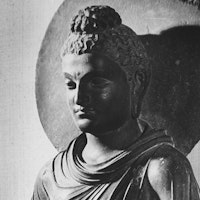A man has faith. If he says ‘This is my faith,’ so far he maintains truth. But by that he cannot proceed to the absolute conclusion: ‘This alone is truth, and everything else is false.’
Gautama Buddha

This Is My Faith
Topic: Interfaith Pathways
Kapathika: “How should a wise man maintain truth?”
The Buddha: “A man has faith. If he says ‘This is my faith,’ so far he maintains truth. But by that he cannot proceed to the absolute conclusion: ‘This alone is Truth, and everything else is false.’ “
Gautama Buddha, also known as Siddhartha Gautama, was a spiritual teacher and the founder of Buddhism. Born in the 6th century BCE in Lumbini, now modern-day Nepal, he was destined for greatness. At the age of 29, he renounced his luxurious life as a prince and embarked on a spiritual quest to find the ultimate truth about human suffering and the nature of existence.
After years of intense meditation and self-discipline, Gautama attained enlightenment under a Bodhi tree in Bodh Gaya, India, at the age of 35. He became the Buddha, which means "the awakened one" or "the enlightened one." Gautama Buddha spent the rest of his life teaching the Four Noble Truths and the Eightfold Path, which formed the core principles of Buddhism. His teachings emphasized the importance of overcoming desire and attachment to achieve liberation from suffering. Known for his compassion and wisdom, Gautama Buddha's teachings have had a profound impact on millions of people worldwide, inspiring them to seek inner peace and spiritual enlightenment. His legacy as a spiritual leader and philosopher continues to resonate and guide individuals on their spiritual journeys to this day.
Majjhima Nikaya
Wilson, Andrew, editor. World Scripture - a Comparative Anthology of Sacred Texts. Paragon House, 1991, p. 39 [Buddha, Majjhima Nikaya 2.176].

Gautama Buddha
Resources
Copyright © 2017 – 2024 LuminaryQuotes.com About Us

Majjhima Nikaya 2.176
Majjhima Nikaya ii.176, Canki Sutta
Walpola Rahula, What The Buddha Taught
It is always a question of knowing and seeing, and not that of believing. The teaching of the Buddha is qualified as ehi-passika, inviting you to ‘come and see’, but not to come and believe. The expressions used everywhere in Buddhist texts referring to persons who realized Truth are: ‘The dustless and stainless Eye of Truth (Dhamma-cakkhu) has arisen.’ ‘He has seen Truth, has attained Truth, has known Truth, has penetrated into Truth, has crossed over doubt, is without wavering.’ ‘Thus with right wisdom he sees it as it is (yatha bhutam)’. With reference to his own Enlightenment the Buddha said : ‘The eye was born, knowledge was born, wisdom was born, science was born, light was born.’ It is always seeing through knowledge or wisdom (nana-dassana), and not believing through faith.
This was more and more appreciated at a time when Brahmanic orthodoxy insisted on believing and accepting their tradition and authority as the only Truth without question. Once a group of learned and well-known Brahmins went to see the Buddha and had a long discussion with him. One of the group, a Brahmin youth of 16 years age, named Kapathika, considered by them all to be an exceptionally brilliant mind, put a question to the Buddha: ‘Venerable Gotama, there are the ancient holy scriptures of the Brahmins handed down along the line by unbroken oral tradition of texts. With regard to them, Brahmins come to the absolute conclusion: “This alone is Truth, and everything else is false’.
Now, what does the Venerable Gotama say about this?” The Buddha inquired: ‘Among Brahmins is there any one single Brahmin who claims that he personally knows and sees that ‘This alone is Truth, and everything else is false?’ The young man was frank, and said: ‘No’. ‘Then, is there any one single teacher, or a teacher of teachers of Brahmins back to the seventh generation, or even any one of those original authors of those scriptures, who claims that he knows and he sees: “This alone is Truth, and everything else is false”?’ ‘No.’ ‘Then, it is like a line of blind men, each holding on to the preceding one; the first one does not see, the middle one also does not see, the last one also does not see. Thus, it seems to me that the state of the Brahmins is like that of a line of blind men.’
Then the Buddha gave advice of extreme importance to the group of Brahmins: ‘It is not proper for a wise man who maintains (lit. protects) truth to come to the conclusion: “This alone is Truth, and everything else is false’.’ Asked by the young Brahmin to explain the idea of maintaining or protecting truth, the Buddha said: ‘A man has a faith. If he says, “This is my faith”, so far he maintains truth. But by that he cannot proceed to the absolute conclusion: “This alone is Truth, and everything else is false”. In other words, a man may believe what he likes, and he may say ‘I believe this’. So far he respects truth. But because of his belief or faith, he should not say that what he believes is alone the Truth, and everything else is false. The Buddha says : ‘To be attached to one thing (to a certain view) and to look down upon other things (views) as inferior – this the wise men call a fetter.’
–Walpola Rahula [What the Buddha Taught by Walpola Rahula, Foreword by Paul Demiéville].